Getting Help with a Genealogy Brick Wall

My Genealogy Brick Wall in Eastern Europe
Reviewing My Work
Legacy Tree Genealogists assigned me to a Project Manager, Camille Andrus, who reached out to discuss what I already knew and what I wanted to learn.
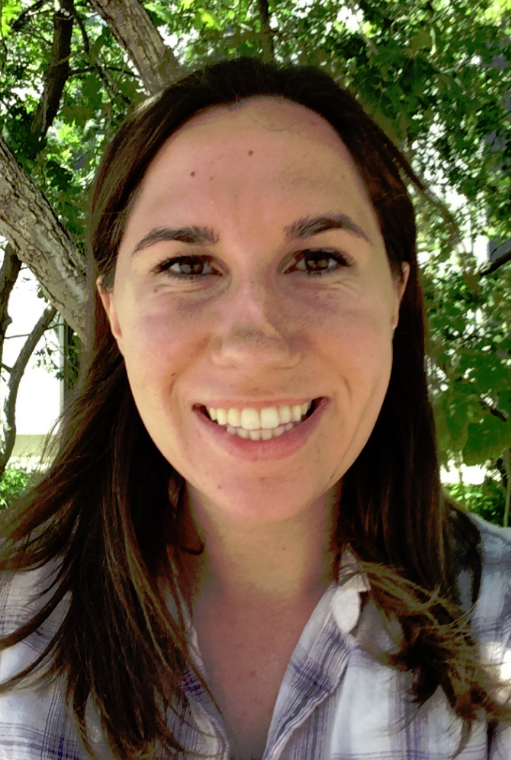
Camille Andrus, Project Manager, Legacy Tree Genealogists.
I requested their Discovery Research Plan, for which they just provide guidance about what record collections to consult and what methods or strategies to try. That way I can do the research myself (which I like doing!). I also asked Camille if she would write about her research process so I could share it with you. Here’s what she sent me:
We looked over Lisa’s work, and upon initial inspection everything looked great.
She had looked in the gazetteer (now available digitally at www.meyersgaz.org with maps of the area) and Lutheran church records. (Editor’s note: Learn more about using Meyers Gazetteer in the Genealogy Gems article 5 Expert Tips for Using Meyers Gazetteer for Your German Genealogy.)
She had searched the records for her ancestor’s supposed home parish. When that failed to yield results, she had done a partial radial search, searching records in several adjacent parishes. Check. Check. Check. She was following all of the integral steps, but still not having success.
What had she missed? What had she done wrong? The short answer — nothing. Her research was impeccable, and she was looking in the right places.
Getting Around the Genealogy Brick Wall
Camille had three specific suggestions for where to look next for great-grandpa Gus. At the end, she also offered some helpful reassurance. Here’s what she said:
1. Civil registration in East Prussia
After closer inspection of what Lisa had already tried, we saw several opportunities we could still pursue.
We looked up civil registration records available through a Polish archive, since what was East Prussia is now part of modern Poland.
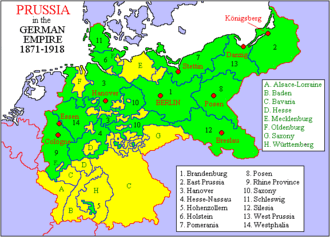
German civil registration in East Prussia began in October of 1874 and is an important resource for researching individuals from this area.
The Meyers Gazetteer confirmed that Kotten (where her ancestor was from) belonged to Kreis Johannisburg in the German Empire province of East Prussia. This village belonged to the Monethen (Kreis Johannisburg) civil registration district.[1]
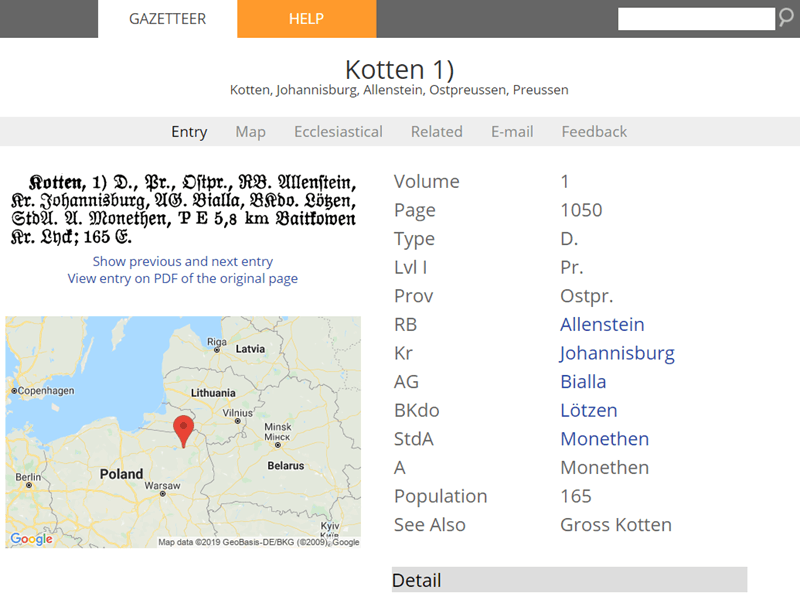
Using Meyers Gazetteer to find German places
The Olsztyn State Archive inventory lists several birth, marriage, death, and family books for the Monethen Civil Registration Office, but the books only cover the late 1930s and early 1940s. The whereabouts of the registers covering 1874 through the early 1930s are unknown.
It appears as though the records covering this time period have been lost or destroyed. This situation is not unusual for East Prussia, in general due to the numerous conflicts that have occurred in the area over time.
2. Church records in East Prussia
Another major resource for German genealogy research is church records.
The Meyers Gazetteer database noted that Protestant residents of Kotten attended church in the nearby town of Baitkowen (Kreis Lyck).[2]
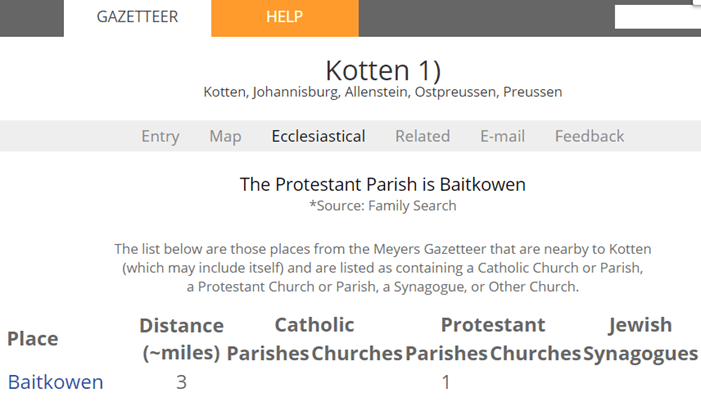
The church book inventory for Baitkowen revealed that the Protestant parish was established in 1891, a decade after the ancestor Gustav Sporowski was reportedly born. No sacramental registers for this parish are known to be extant. It should be noted that the Baitkowen parish was created from parts of the Lyck, Ostrokollen, and Drygallen parishes.[3]
The Protestant parish of Drygallen (Kreis Johannisburg) has extant baptismal records which are available on microfilm at the Family History Library for the years 1730-1821 and 1844-1875.[4] Lisa indicated that she had reviewed these files but did not find any Sporowskis.
The Lyck Landgemeinde (the congregation for parishioners living outside city limits) was founded in 1704, but there are no known extant baptismal records for this parish after 1808.[5]
3. Following up on clues
A key clue came from Lisa’s notes. She mentioned that Gustav and his wife were married in Lütgendortmund, a town hundreds of miles west of Gustav’s birthplace, before ultimately immigrating to the United States.
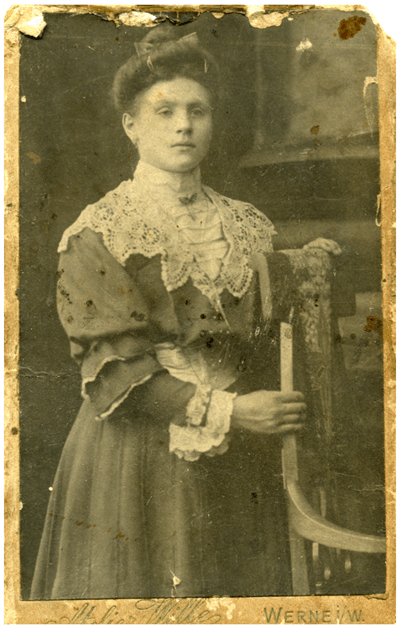
Louise at the time of her marriage
Luckily, their marriage occurred in a time when civil registration had been instituted. A search for marriage records showed there are civil registration records available for the town of their marriage, which are available at an archive in Detmold.
We were able to advise Lisa that further research should pursue this record, as it may list information about his parents.
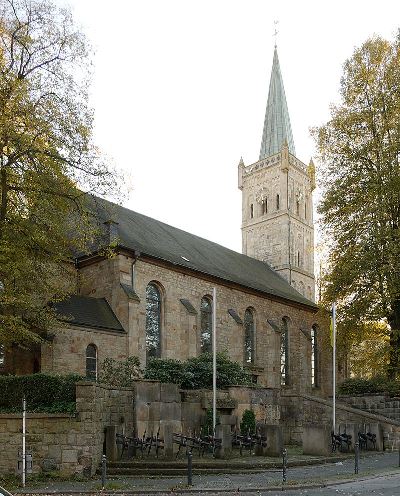
The Protestant Bartholomew Church in Lütgendortmund, Dortmund, Germany. Von Smial – Eigenes Werk, FAL. Click to view.
The Bottom Line
The bottom line is if you feel stuck, it’s not necessarily because you are doing anything wrong.
Review the “checkboxes” of your research plan to ensure you aren’t missing any integral clues.
If after final review of methodology concludes that you’ve pursued every avenue, the lack of success may be attributed to gaps in the records or perhaps they have been lost completely. Other times all you need is one clue to put you back on the right track.
This is exactly the kind of advice I was hoping for: expert and specific!
Hire a Professional Genealogist for a Quick Consult or Project
If you have hit a genealogy brick wall in Eastern Europe (or anywhere else) and would like a professional to review your work, I recommend contacting Legacy Tree Genealogists. They have helped many clients like me to solve their family history mysteries, and would love to help you as well!
You can hire a genealogist like Camille through their Genealogist-on-Demand™ service. Receive research strategies and advice from a professional genealogist during your 45-minute consultation that will help you continue your own research. Your virtual genealogy consultation will allow you to have your questions answered in real-time by an expert–all from the comfort of your own home!
Need even more help? Here’s an exclusive offer for Genealogy Gems readers: Receive $100 off a 20-hour research project using code GGP100. To learn more about Legacy Tree services and its research team, visit https://www.legacytree.com.
Disclosure: This article contains affiliate links and Genealogy Gems will be compensated if you make a purchase after clicking on these links (at no additional costto you). Thank you for supporting Genealogy Gems!
[1] Search the Meyers Gazetteer, Kotten, Johannisburg, Allenstein, Ostpreussen, Preussen, http://meyersgaz.org/place/11050078, accessed August 2017.
[2] Search the Meyers Gazetteer, Kotten, Johannisburg, Allenstein, Ostpreussen, Preussen, http://meyersgaz.org/place/11050078, accessed August 2017.
[3] Ostpreussen, Genealogische Quellen, Kirchbuchbestände Kreis Lyck, ev. Baitkowen (Baitenberg), http://wiki-de.genealogy.net, accesesed August 2017.
[4] Ostpreussen, Genealogische Quellen, Kirchbuchbestände Kreis Johannisburg, ev. Drigelsdorf (Drygallen), http://wiki-de.genealogy.net, accesesed August 2017.
[5] Ostpreussen, Genealogische Quellen, Kirchbuchbestände Kreis Lyck, ev. Lyck Stadtgemeinde, http://wiki-de.genealogy.net, accesesed August 2017.
How to Get Dual Italian Citizenship
Learn how to get dual Italian citizenship using genealogical information with my guest professional genealogist Sarah Gutmann of Legacy Tree Genealogists.
Watch Live: Thursday, May 12, 2022 at 11:00 am CT
(calculate your time zone)
Three ways to watch:
- Video Player (Live) – Watch video premiere at the appointed time in the video player above.
- On YouTube (Live) – Click the Watch on YouTube button to watch the YouTube premiere with Live Chat at the appointed time above at the Genealogy Gems YouTube channel. Log into YouTube with your free Google account to participate in the live chat.
- Video Player above (Replay) – Available immediately after the live premiere and chat.
Show Notes
My special guest is Sarah Gutmann. Sarah began her obsession with family history when she was 13-years-old. She now has almost three decades of experience helping others climb their family tree. She is a professional genealogist with Legacy Tree Genealogists where she specializes in United States and Italian research. As a veteran classroom teacher, Sarah enjoys teaching various genealogy programs to libraries, historical societies, and lineage organizations across America.
Obtaining Italian Dual Citizenship Overview:
- Who can become a citizen?
- Finding out when your ancestor naturalized and obtaining those documents
- Identifying your ancestor’s specific commune (village)
- Using the Italian archives site
- Requesting vital records from Italy
- Obtaining long form vital records with an Apostille (American records)
Who can apply for dual Italian citizenship?
The following list refers to examples of some categories of eligible persons:
- Direct Descent: from an Italian-citizen parent (if maternal side, after January 1 st, 1948) born in Italy and they were still Italian citizens at the time of the Applicant’s birth. The Applicant and their parents must have never renounced their Italian citizenship. Naturalizations occurred prior to August 15th, 1992 constituted renouncing ones’ Italian citizenship.
- Through Descent: from an ancestor born in Italy who was an Italian citizen at the time of the birth of their child. The Italian citizenship would pass through the generations up until the Applicant (the maternal branch could pass on Italian citizenship to children born after January 1, 1948), provided that none of the descendants in the straight line lost/renounced their Italian citizenship, such as through naturalization prior to August 15th, 1992.
- From an Italian-citizen mother to a child born before January 1st, 1948: applicants who fall into this category will have to appeal to an Italian civil court to obtain the recognition of citizenship.
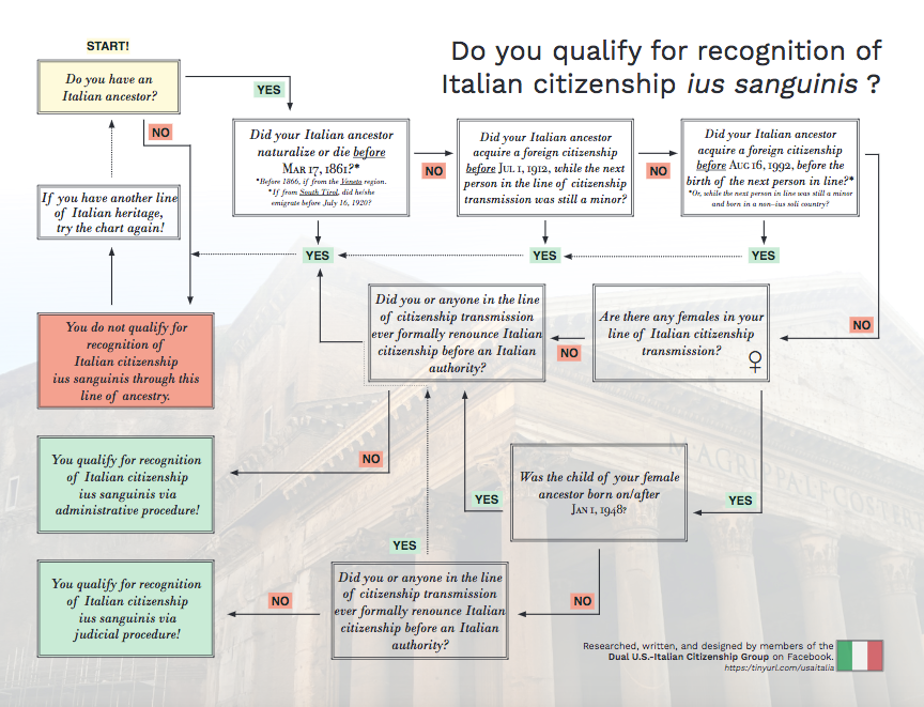
Italian dual citizenship process chart (Source: Dual U.S. Italian Citizenship Facebook Group)
How Do I Know When My Ancestor Naturalized?
Using Census Records:
- Take note of the year of immigration
- Look for passenger records
- Naturalization
- AL- Alien
- NA- naturalized
- PA- have submitted the first papers to become naturalized
- Find Them at Family Search – FREE!
Use the census record as a guide to what court your ancestor may have naturalized through.
Looking for Naturalization Records
- Prior to September 27, 1906, any “court of record” (municipal, county, state, or Federal) could grant United States citizenship.
- Beginning September 27, 1906, naturalization was done through the Federal courts.
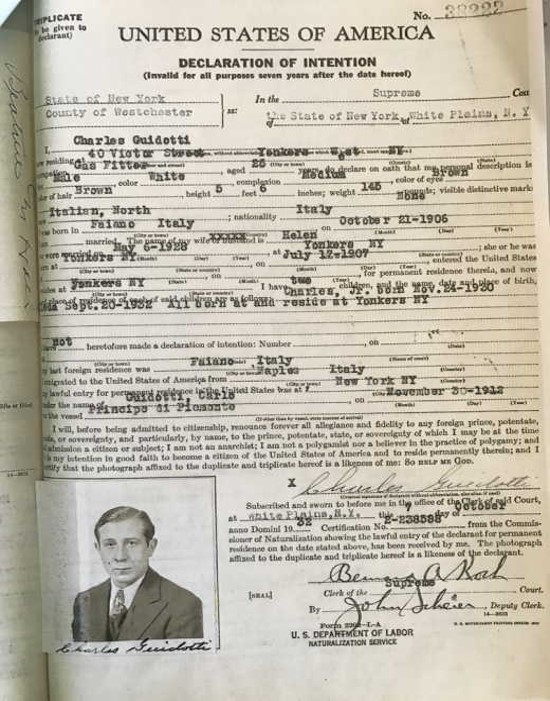
Example: Naturalization Declaration of Intention
Contact U.S. Citizenship and Immigration Services. They have records from 1906 forward.
Order an “Index Search”
On the Genealogy page at the U.S. Citizenship and Immigration Service website click Order an Index Search or Record Request.
Provide as much information you know about the immigrant
- Name
- Addresses in America
- Birthdate and place
- Household members
- Year of immigration
Order Record Request with Request Case ID.
Did Your Immigrant Ancestor Naturalize AFTER Their Child Was Born?
Start Gathering Vital Records!
Vital Records Issued by Italian Authorities
Here are the Italian vital records for events which took place in Italy:
In Line Relatives:
- Birth Certificate: Original Extended Certified Copy Issued by the Comune, with names of parents
- Marriage Certificate: Original Extended Certified Copy Issued by the Comune, with names of parents, and any annotations of divorces
- Death Certificate: Original Extended Certified Copy Issued by the Comune, with names of parents
Out of Line Relatives if born in Italy:
- Spouse’s Birth Certificate: Photocopy of Certificate Issued by Comune in Italy
- Spouse’s Death Certificate: Photocopy of Certificate Issued by Comune in Italy
Finding the Italian Village of Origin
Here are some of the records that may include your ancestor’s village of origin:
- Naturalization Record
- Ship Manifest
- Draft Record
- Vital Records (Birth, Marriage, Death)
- Obituary
If you don’t have success with your ancestor’s records, try searching your Ancestor’s FAN CLUB (Friends, Associates, Neighbors). These are the people who may have come from the same village. Search for their records as listed above.
Contacting the Italian Comune
- Use Comuni-Italiani.it to locate your comune’s website
- Find the comune’s email address and regular mail address
- Write a request letter in Italian and include your i.d. (Letters are available in the “forms” at the Consulate Generale website)
- Follow up! Follow up!
The Comuni-Italiani.it Webiste
Website: http://www.comuni-italiani.it/
This website provides Information and statistics on municipalities, provinces and regions in Italy. You’ll find links to official websites, zip code, number of inhabitants, banks, schools, pharmacies, maps, weather forecast, and other useful links.
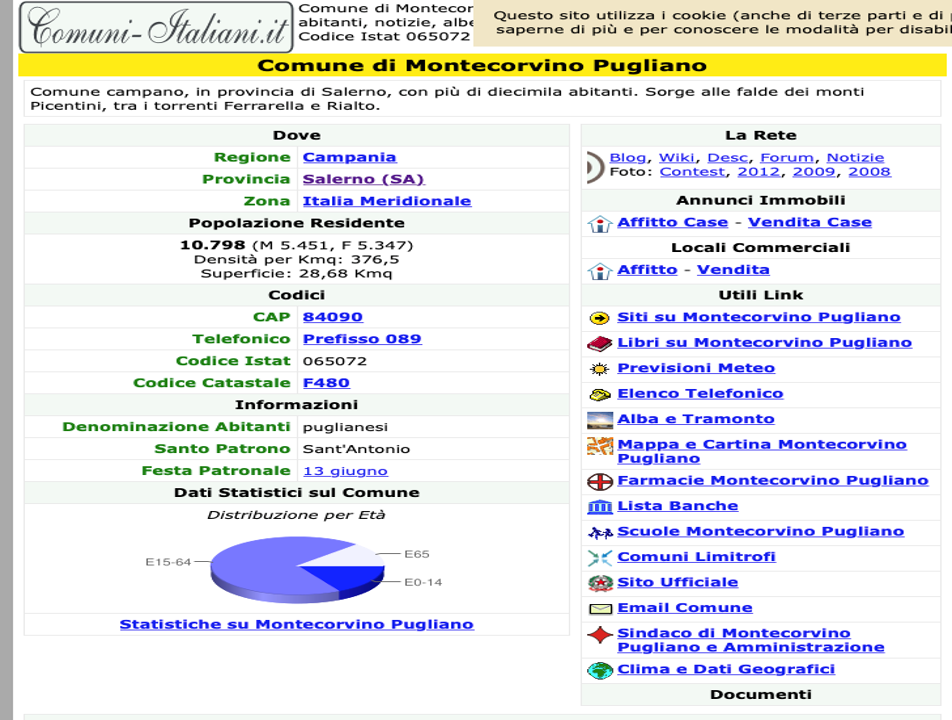
Website: http://www.comuni-italiani.it/
Here’s an example of the official Italian document you are trying to obtain:
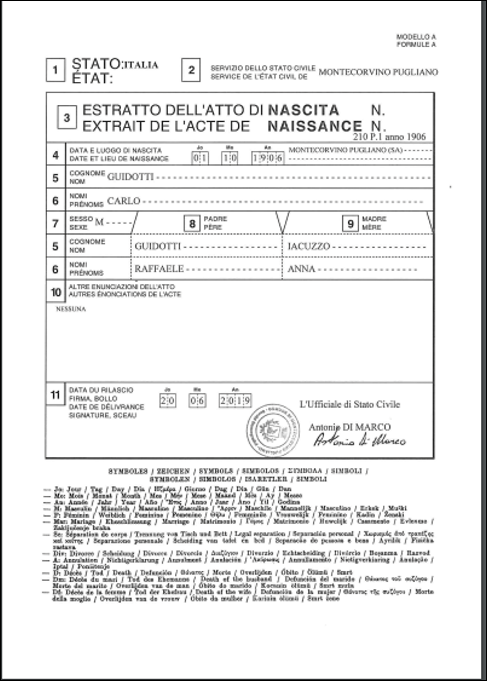
The goal
This is your golden ticket to the Italian consulate and getting that coveted citizenship.
Vital Records Issued by Non-Italian Authorities (American Records)
In Line Relatives ORDER NEW DOCUMENTS
- Long Form Original Legalized by the Apostille & Translation of Document Only
- Birth Certificate
- Marriage
- Divorce
- Death Certificate
Out of Line Relatives
- Photocopy of birth and death
What is an Apostille?
An Apostille (pronounced “ah-po-steel”) is a French word meaning certification. An Apostille is a specialized certificate, issued by the Secretary of State. The Apostille is attached to your original document to verify that it is legitimate and authentic.
Research your General Italian Consulate
- MAKE YOUR APPOINTMENT!!!!
- Fill out Citizenship forms
- Download checklist and instructions
Resources
Downloadable ad-free Show Notes handout for Premium Members.
Learn more about becoming a Genealogy Gems Premium Member.



